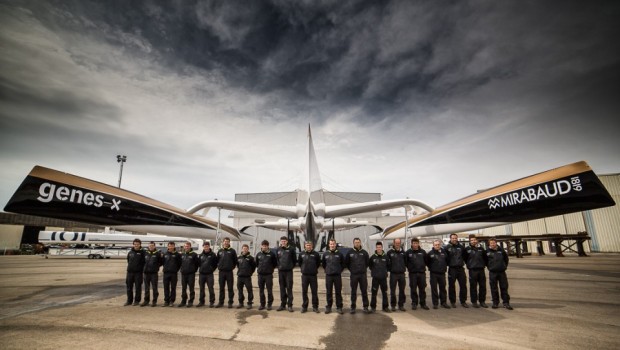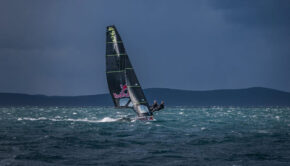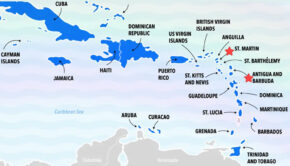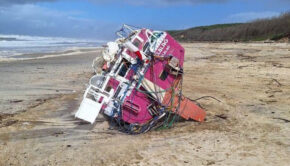Spindrift: World’s largest racing trimaran
Published on April 8th, 2014
After three months of ambitious boatbuilding, the 40-meter trimaran Spindrift 2 was re-launched this month in Lorient, France. As the largest racing trimaran in the world, it has been optimised for the demanding program that is planned for 2014.
The Spindrift Racing team, led by Dona Bertarelli and Yann Guichard, will be on standby in the United States from the start of June, waiting in Newport for a good window to tackle two prominent crewed records the boat had previously set (as Banque Populaire V) by Pascal Bidegorry in August 2009.
Spindrift 2 will seek to better the 2880nm Transatlantic Record (New York City to Lizard Point) of 3d 15h 25 min 48s (32.94 knots) and the 24 hour distance record of 908 miles (37.84 knots).
To appreciate this maxi trimaran, acclaimed sailing writer G. Bruce Knecht joined the team prior to the refit. Here is his report…
Sunrise was still an hour away when I arrived in the port of Lorient. At first, it was difficult to see much of anything. Three 131-foot-long hulls and a towering mast were jet black, as were the uniforms of the crewmen, who moved about with the help of head-mounted flashlights.
“Welcome to the world’s largest racing trimaran,” Bertarelli said as I stepped aboard.
Named for the spray of water launched by the hulls as they charge through the sea at speeds that were, until recently inconceivable for a large sail-powered vessel, Spindrift 2, is as fast as the catamarans that began racing for the America’s Cup the same week I was in Lorient. And it has far greater endurance: In 2012, its previous owner and former namesake, French financial institution Banque Populaire, sailed the boat around the world in an astonishing 45 days, breaking another record set by Franck Cammas, who did it in 48 days in 2010.
Bertarelli–whose fortune came from Serono, the Italian pharmaceutical giant founded by her grandfather–caused a stir when she purchased the boat in January 2013, in part because a female owner and co-skipper would be rarity in the male-dominated world of yacht racing. And there was her familial connection to the sport: Her billionaire brother Ernesto founded and led the Swiss team that won the America’s Cup in 2003 and 2007.
“I ended up getting really excited about competitive sailing,” she told me of her brother’s influence,” and being a spectator wasn’t enough.”
The story also has a romantic dimension. Bertarelli’s co-skipper would be her partner, French yachtsman Yann Guichard. Their relationship began a few years earlier when Bertarelli hired Guichard to serve as coach for a catamaran she raced with an all-female crew on Lake Geneva.
“Yann and I wanted to have a common project,” Bertarelli said in explaining her decision to buy Spindrift 2. “It would take a year and a half to design something like this one and another year and a half to build it. This boat was launched in 2008 and it’s still very competitive. If we can find ways to improve its performance, we believe we have a window of four to five years to break some records.”
The goal for the day was to perfect various techniques and enhance the crew’s cohesiveness. First, though, they had to get the boat away from the dock. With its 75-foot width, Spindrift 2 is an awkward best, something like a sumo wrestler in a teashop, which is why we had to assemble so early. The forecast called for heavy wind later in the day, which would not be a problem except for the need to exit a narrow waterway beforehand.
As a trio of tenders–each powered by an engine with at least 150 horsepower–worked like little tugboats to guide Spindrift 2 away from the dock, Guichard was standing at one of the two large steering wheels. They are positioned at opposite sides of the boat so that the helmsman can always steer from the windward hull, the one that lifts out of the water when the breeze is good.
Once we cleared the harbor, when the wind speed was 12 knots, Guichard asked the 14-person crew to raise the 4,800-square-foot mainsail and a smaller headsail. As the sails filled, the port hull levitated from the water and we accelerated rapidly. We were soon moving at twice the speed of the wind. If that’s a concept that’s difficult to grasp, another fact of super-fast sailing was all too apparent: You do not want to fall off the boat. “After two minutes in the water, it would be impossible to see the person in the water,” Bertarelli told me. “After five, that person wouldn’t be able to see the boat.”
As we sailed away from the coast, we were moving so quickly that seagulls could not begin to keep pace, and before long, we had lost sight of land. When we were 28 miles off the coast, Guichard turned the helm over to me.
I have loved sailing ever since my grandfather launched me in a dinghy in Edgartown Harbor when I was nine years old. Since then, I have sailed relatively small–and slow–boats whenever I got the chance. I have some experience on larger boats. My first book, The Proving Ground, was about the 1998 Sydney to Hobart Race, the tragic competition in which several boats sank and six sailors died. When I was researching the book, I sailed on Brindabella, the 75-footer that played a central role in the story, during short races in Sydney Harbor. In 2005, I was aboard the large single-hull sailboat Mari-Cha IV when it broke the 100-year-old transatlantic race record. But most of my sailing is on a 28-foot sloop, which rarely leaves the protected waters of Long Island Sound. Going fast means seven knots.
The basic task of steering Spindrift 2–maintaining a course that took us generally where we wanted to go while taking maximum advantage of the wine–was fundamentally no different than on my boat, but the extraordinary speed meant that I had to rely on a digital readout of the wind’s direction rather than how it felt as it crossed my face. Spindrift 2’s speed was intoxicating–though it inevitably led to a desire for even more. I could not resist making frequent checks of another digital indicator, the one showing our speed. I was able to keep it close to 30 knots, and at one point I got it up to 35.4–or 41 miles per hour–which turned out, to my great surprise, to be our top speed of the day.
The speed produced a cacophony of sound. The shrouds were not just whistling but also were causing sections of the boat’s carbon-fiber structure to vibrate. The deck on which I was standing made an audible thumbing noise every few seconds, which I also felt through the soles of my shoes. A particularly arresting sound came from the rudder mounted on the back of the hull nearest to me. When I was doing my job well, this hull and the entire length of the rudder flew above the water. When I slipped up, the hull dropped down a bit and the rudder pierced the surface of the water to produce a loud hiss that sounded like that of an angry cat. It was a sound I enjoyed–more dramatically than the speed indicator, it gave proof to our remarkable pace–but it also seemed a bit like chastisement, or perhaps a warning.
There is no getting around the fact that Spindrift 2’s speed carries risks. Things could go wrong, in seconds. Structural elements could break. Was that thumping at my feet an indication of trouble? And then there is the ultimate fear: The boat could capsize.
Last June, Guichard was racing another boat owned by Bertarelli, a MOD70 trimaran, off the coast of Ireland when a sudden gust caused it to overturn. The mast crumbled and a member of the crew, Guichard’s brother Jacques, suffered a broken pelvis.
We had a close call as we sped off the coast of France. It came after the wind gusted from 18 knots to 33, which caused the windward hull to rise much too far out of the water. The crewman who should have released the headsail was slow in doing so, so the boat tipped further and further until the mast was 21 degrees beyond vertical. By then, Guichard, who was at the wheel, was unable to steer. Turning the wheel had no effect. Spindrift 2 was out of control. Guichard has a reputation for never losing his cool, but he was clearly worried as he shouted instructions and pulled at the wheel in a futile attempt to turn toward the source of the wind.
Eventually, when the headsail was eased, the hulls fell back toward the water, averting catastrophe. Nobody talked about the incident until later, when we were back at the dock and Guichard spoke about the day’s lessons learned, but it was a haunting moment.
It was impossible not to think about how the dangers would compound with even stronger gusts and at night during an ocean crossing. As we headed back to shore, I asked Bertarelli, who has three children with her former husband, plus a multibillion-dollar fortune, why she chose to risk it all rather than spending her time on a luxurious yacht or at her home in Gstaad, the gilded Swiss mountain village where she owns the elegant Grand Hotel Park. Her answer, predictably, was all about speed.
“On this boat, you can actually feel the acceleration–there’s a kind of kick–and that’s something you just don’t get on a traditional monohull sailboat,” she said. “When you’re on a multihull, you actually have the sense of flight.”
Republished from Rhapsody, the United Airlines inflight magazine
Editor’s note: Following Bruce’s excursion with the team, Dona Bertarelli and Yann Guichard led the maxi trimaran Spindrift 2 to beat the 3885-mile Discovery Route record, setting a new time of 6 days, 14 hours, 29 minutes and 21 seconds at an average speed of 24.5 knots. The route extends from Cadiz, Spain to San Salvador in the Bahamas, but must pass through the Canary Islands. Full report.









 We’ll keep your information safe.
We’ll keep your information safe.